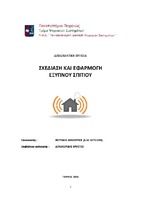Σχεδίαση και εφαρμογή έξυπνου σπιτιού

View/
Keywords
Έξυπνα σπίτια ; Διαδίκτυο των Πραγμάτων ; Raspberry Pi ; GPIO ; Smarthomes ; Internet of ThingsAbstract
Nowadays, more and more people are using smart devices in order to satisfy their needs with a quick and convenient way. During the last decade, the smartphones entered to our every day and our day-to-day life has been improved. For the time being, what is the next step to wait from the technology?
Although it is difficult to answer this question, it seems that one of the future steps in the field of technology is the transition to IPv6 and as a result the spreading of Internet of things. Everything around us is “smart”, we have smart-phones, smart-watches, smart-cameras and other smart devices but for the time being it seems that we do not owe smart homes.
The goal of this thesis is to find out a way to live the future now by converting every existing home to smart home focusing on facts like cost, parameterization and flexibility.
Taking into consideration the low cost and the rest facts, foe implementing a smarthome, the microcontroller Raspberry Pi seems to be the most suitable solution to address these issues. The Raspberry Pi is a low cost, credit-card sized computer that plugs into a computer monitor or TV, and uses a standard keyboard and mouse. It has the ability to interact with the outside world, and has been used in a wide array of digital maker project.
Now that we know what exactly Raspberry Pi is, we are in a position to study in detail the main functionalities that a smart home can support by categorizing them by lighting, heating, telephony, alarm, energy and notifications.
The main goal of this thesis is the design and the implementation of a smart home. The raspberry Pi can achieve this goal and the implementation that I have developed is the proof. An application that handles the lights, the garage door, the generated energy from the solar panels and the telephony was implemented by using only one raspberry pi and the corresponding peripherals.
Finally, the most common question that is raised is the cost that smart-devices may have in a traditional house. The last chapter includes a study plan that provides answers to this question and can be used as an input for a techno economic study of a startup company which will be focused on selling smart home devices.


